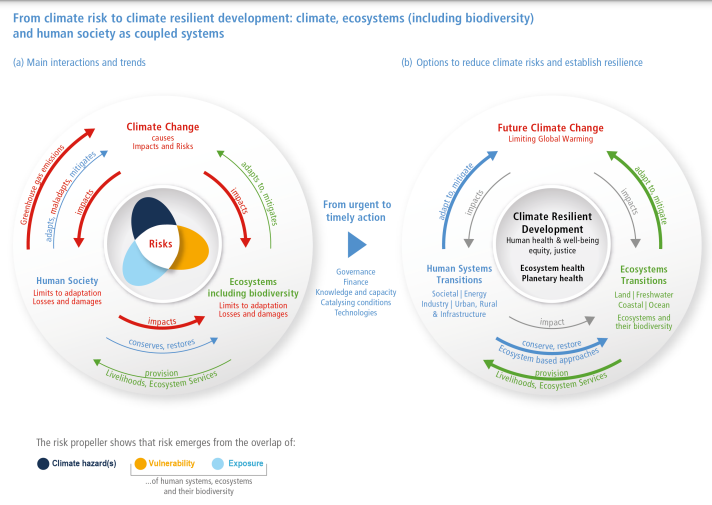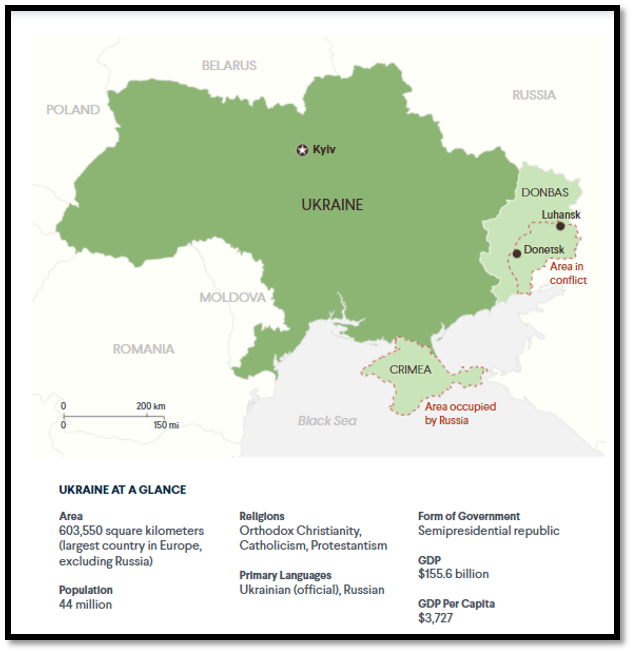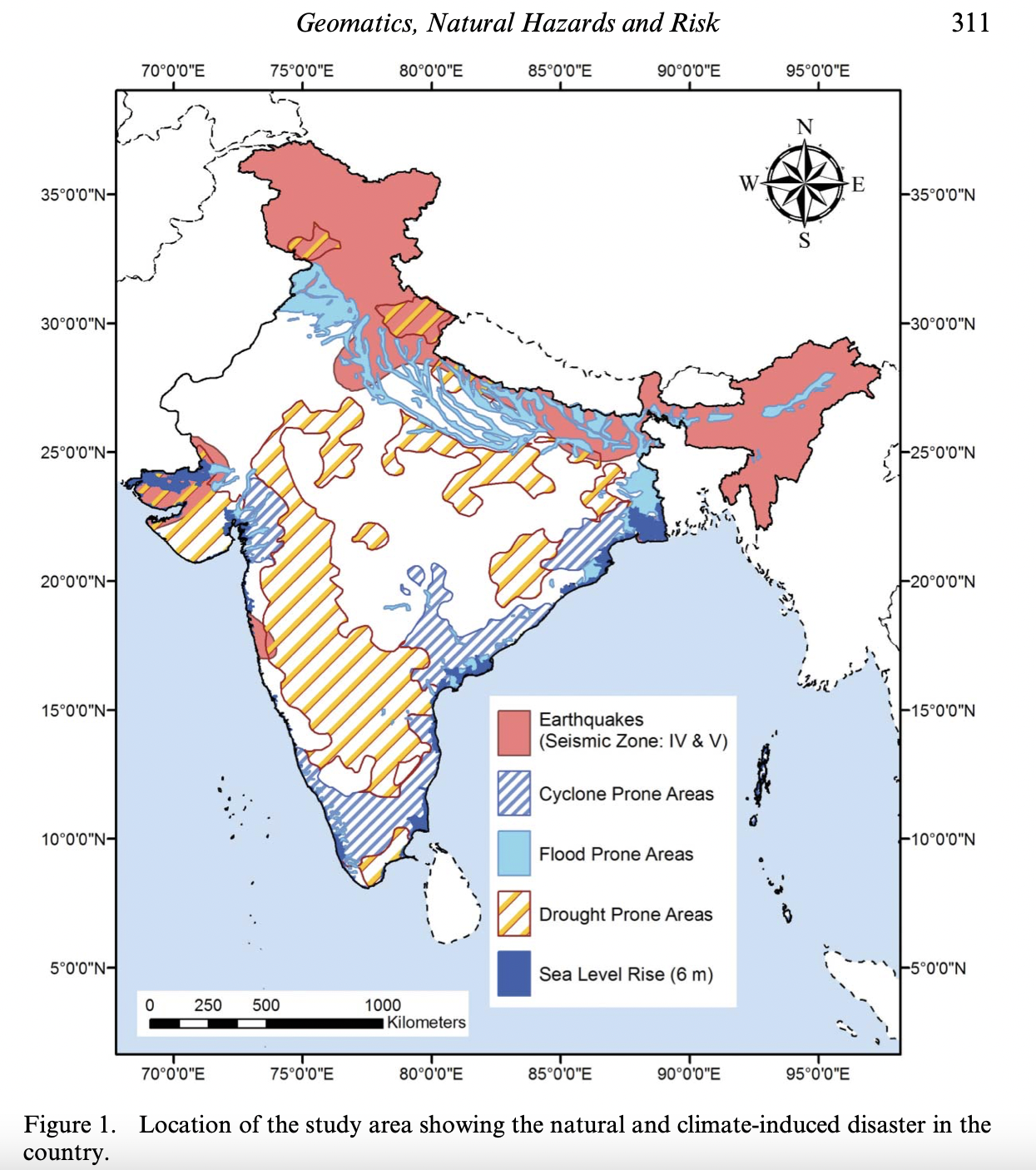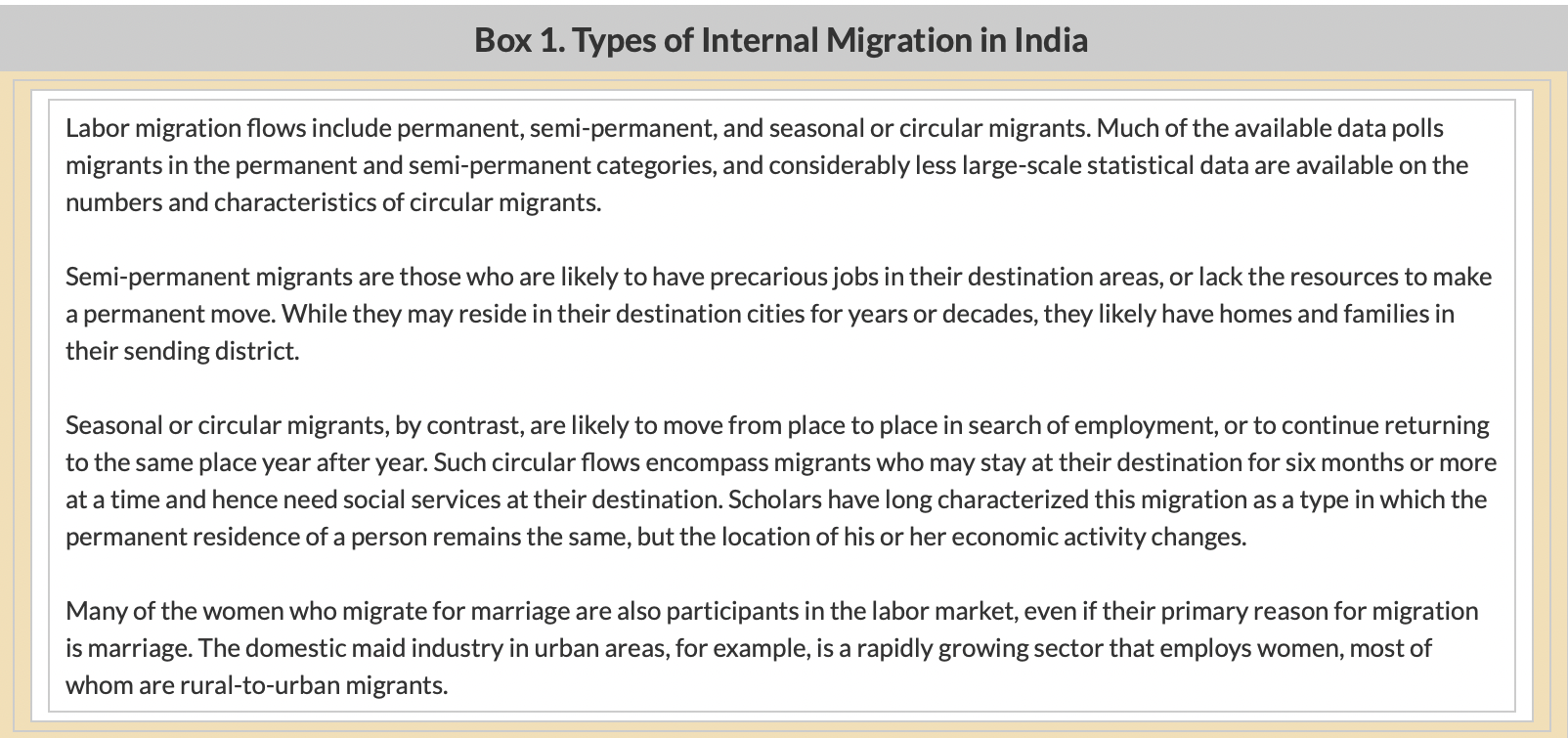19 Mar
IPCC Working Group II Report (Part 2: Adaptation, Loss & Damage and Climate Resilient Development) Feature #1 Climate Change Adaptation
Introduction: Climate adaptation is far more prominent in the new report than any previous IPCC assessments. The WG2 report of the IPCC’s fourth assessment (AR4) – published in 2007 – included one chapter about adaptation. The AR5 WG2 report expanded this to four chapters. In contrast, AR6 has integrated adaptation comprehensively throughout the report. This reflects both an expansion of knowledge and heightened urgency.
What is climate change adaptation?
- Adaptation refers to adjustments in ecological, social, or economic systems in response to actual or expected climatic stimuli and their effects or impacts.
- It refers to changes in processes, practices, and structures to moderate potential damages or to benefit from opportunities associated with climate change.
- Adaptation solutions take many shapes and forms, depending on the unique context of a community, business, organization, country or region.
- There is no ‘one-size-fits-all-solution’—adaptation can range from building flood defences, setting up early warning systems for cyclones and switching to drought-resistant crops, to redesigning communication systems, business operations and government policies.
- Parties to the UNFCCC and its Paris Agreement recognize that adaptation is a global challenge faced by all with local, subnational, national, regional and international dimensions. It is a key component of the long-term global response to climate change to protect people, livelihoods and ecosystems.
Climate change adaptation v/s mitigation
- Adaptation is the process of adjusting to the current and future effects of climate change whereas mitigation means making the impacts of climate change less severe by preventing or reducing the emission of greenhouse gases (GHG) into the atmosphere - g. by increasing the share of renewable energies, or establishing a cleaner mobility system etc.


How do countries address adaptation under the UN climate change regime?
- Within the UN climate change regime, Parties carry out adaptation-related activities in a number of workstreams, through work programmes and in specialized groups and committees. These include:
- National adaptation programmes of action (NAPAs)
- National Adaptation Plans
- Adaptation Committee
- The Least Developed Countries Expert Group (LEG)
- Nairobi work programme on impacts, vulnerability and adaptation to climate change
- Technical Examination Process on Adaptation

The status of climate change adaptation around the world
- There are numerous targets in place for adaptation, including the Sendai Framework for Disaster Risk Reduction and the finance-oriented Addis Ababa Action Agenda.
- The Paris Agreement itself also includes a “global goal on adaptation”.
- The new AR6 noted that the extent of adaptation-related responses globally has been low. The report concludes that, barring some measures to deal with flooding and extreme heat, there is “negligible evidence that existing responses are adequate to reduce climate risk”.
- According to the report, these adaptation gaps are mainly attributed to
- Lack of sufficient adaptation finance.
- Major knowledge gaps persist in modeling and analysis.
- Lack of political commitment and a sense of urgency.
- A key issue identified in the new AR6 report is that specifying adaptation goals is harder than for mitigation, which can simply be judged by volumes of emissions.
Metrics to assess adaptation
The report identifies three metrics to assess adaptation: effectiveness, feasibility, and justice.
- Effectiveness is broadly defined as the extent to which a solution reduces climate risk, although it can also include economic benefits and measures of wider societal wellbeing.
- Feasibility is the extent to which it is considered possible and desirable, “taking into consideration barriers, enablers, synergies, and trade-offs”.
- Climate justice can mean many things to many people, but the report notes that generally “it is common to distinguish between distributive justice, procedural justice and recognition”. These are defined as follows:
- Distributive justice: Adaptation solutions aim to achieve fairness between individuals, states and generations.
- Procedural justice: Such actions should also involve “genuine, not merely formal” participation from people affected, requiring communities to be well-acquainted with climate risks and given a voice in adaptation planning.
- Recognition: This involves basic respect and robust engagement with and fair consideration of diverse values, cultures, perspectives, and worldviews. It is closely tied with the first two and without it actors “may not benefit” from them.
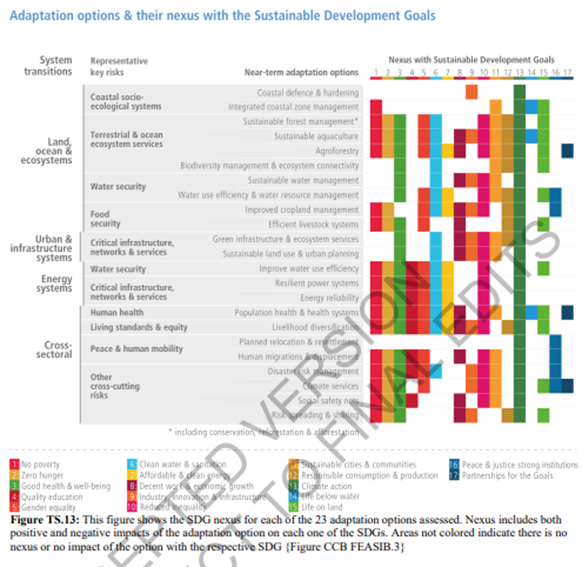
Diverse examples of climate adaption efforts cited across the IPCC’s new AR6:
- Planting trees “in the right place” to provide shade for people, livestock, crops and even water sources, which can help to keep temperatures low and maintain fisheries.
- Restoration of mangroves, saltmarshes and sea grass meadows, which can both remove CO2 from the atmosphere and protect coasts from the impacts of storms and sea-level rise.
- Farmers in semi-arid areas adapting to changing rain patterns by using
- Taking an agro-ecological approach to reduce risk in food systems, improve food security and reduce costs.
- Managing flood risk in cities by installing flood proofing in properties, improving drainage along roads, incorporating nature-based solutions, constructing flood defenses and reducing runoff from land upstream.
- Supporting “safe and orderly movements of people”, protecting migrant rights and facilitating financial flows “between sending and receiving communities”, to adapt to climate migration.
- Public and private investment in different types of assets, including water and sanitation, education and healthcare, to help make the world’s poorest people more resilient to climate change.

Limits to Adaptation
- The limits to adaptation are the points at which it is difficult or even impossible to accommodate the changes the world is undergoing.
- This idea of an adaptation limit, first introduced in AR5 in 2014, is defined as “the point at which an actor’s objectives or system’s needs cannot be secured from intolerable risks through adaptive actions”.
- These limits “strongly affects any appropriate balance among adaptation and mitigation actions” as a failure to cut enough emissions could render adaptation futile”. In other words, if there are numerous limits on adaptation, mitigation efforts will need to be ramped up.
- These limits are categorized as either “soft” or “hard’, and are distinguished by the extent to which it is possible to overcome them.

- The nature-based solutions such as coral reefs, mangroves, and marshes, all of which can help adaptation efforts – will likely reach hard limits of their own as the planet warms beyond 1.5C.

Transformational Adaptation

- Responses to the adverse impacts of climate change can be categorized into three major types:
- Coping responses: These are strategies that people use to resist the impacts from climate change and maintain the affected social-ecological system in a similar state or business-as-usual functioning.
- Incremental adaptation: This includes strategies to continue to provide benefits by accommodating changes. Incremental adaptation strategies drive minor and small-scale adjustments to current social-ecological systems and focus on building their resilience to climate change impacts.
- Transformational adaptation: It is a strategy that aims to reduce the root causes of vulnerability to climate change in the long-term by shifting systems away from unsustainable or undesirable trajectories. It relates to fundamental systemic changes that create new states and interactions within social-ecological systems.
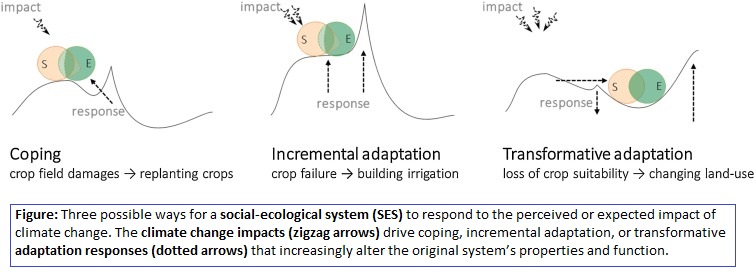
Maladaptation
- The report also explores “maladaptation”, which it describes as adaptation measures that “lead to an increase in the climate vulnerability of a system, sector or group”, either now or in the future.
- Maladaptation differs from ‘failed’ or ‘unsuccessful’ adaptation, which describes a failed adaptation initiative not producing any significant detrimental effect.
- Metrics to assess the success of adaptation projects include benefits to people and wildlife, potential to reduce emissions and “equity outcomes” for marginalized ethnic groups, women, and low-income populations.

Maladaptive Mitigation
- The report also explores “maladaptive mitigation”- the unintended consequences of measures to tackle greenhouse gas emissions.
- It gives examples of how measures to tackle climate change may pose a risk to people or biodiversity. For example, the expansion of renewable energies such as solar and wind could impose on areas of biodiversity.
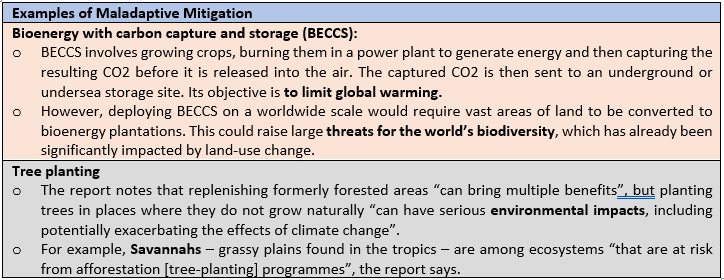
Role of nature-based solutions (NbS) in adaptation and mitigation:
- The report notes that, nature-based solutions (NbS) provide adaptation and mitigation benefits for climate change as well as contributing to other sustainable development goals.
- However, these nature-based solutions cannot be regarded as an alternative to, or a reason to delay, deep cuts in greenhouse gas emissions.
- Important nature-based solutions (NbS) suggested by the report:
- Forests: Keeping “existing natural forests” standing and sustainably managing “semi-natural forests” “is a highly effective NbS”.
- However, the reports warns that afforesting savannahs, natural peatlands and other areas that do not naturally house forests damages biodiversity and increases vulnerability to climate change. So it is not a Nature-based Solution and can exacerbate greenhouse gas emissions.
- Peat lands: Peatlands are naturally high-carbon ecosystems, which have built up over millennia.
- Protecting intact “peat forests” – tropical moist forests in swampy soil – is by far the more effective pathway both in terms of cost, CO2 mitigation and protection of food sources.
- Rewetting dried peatlands and preventing further cutting and burning can help restore some temperate peatlands.
- Agroecology and agroforestry:
- Forests: Keeping “existing natural forests” standing and sustainably managing “semi-natural forests” “is a highly effective NbS”.

-
- Blue carbon and oceans: The report states that blue carbon strategies can be effective NbS for climate mitigation, but their overall global or regional potential may be limited. However, they can counteract sea level rise effects, buffer storm surges and flooding erosions, providing climate adaptation, biodiversity, cultural and socio-economic benefits.
- Restoring dunes and coastal wetlands to reduce coastal risks and act as a buffer between infrastructure and the sea yields immediate benefits.
- While marine protected areas do not prevent marine heat waves, they can increase climate resilience by removing additional stressors.
- The report considers sustainable fishing to be an NbS, because sustainably managing marine commercial species maximizes the catch and food production, thus contributing to the UN’s zero hunger goal.
- Urban NbS: Carefully designed urban greening in cities and well-functioning ecosystems can play a significant role in buffering cities, settlements and infrastructure from climate hazards.
- Investing in “green and blue infrastructure” and natural area conservation in cities. From reducing temperature shocks and providing natural flood defences to physical and mental health co-benefits, urban NbS provide many adaptation and resilience benefits.
- Street trees, green roofs, green walls and other urban vegetation are among the strategies that can reduce extreme heat by cooling private and public spaces.
- Urban farming can serve as an NbS for food security.
- Blue carbon and oceans: The report states that blue carbon strategies can be effective NbS for climate mitigation, but their overall global or regional potential may be limited. However, they can counteract sea level rise effects, buffer storm surges and flooding erosions, providing climate adaptation, biodiversity, cultural and socio-economic benefits.

Feature #2 Loss and Damage
Background:
- Loss and Damage refers to harms caused by climate change, including both rapid-onset events, such as hurricanes, and slow-onset events, such as gradual sea level rise.
- It is highlighted in the report as an area of increasing importance in both international climate policy and climate science.
- The report noted that with increasing global warming, losses and damages will increase and additional human and natural systems will reach adaptation limits.
- The IPCC’s first assessment of the scientific literature on loss and damage came in its 1.5C report in 2018, following an intervention by concerned member countries. It identified a rise in “residual risks” as temperatures increased, such as the decline of coral reefs and coastal livelihoods.
- The 2018 report concluded there was “not one definition” of loss and damage and the new WG2 report concludes that this ambiguity has persisted and a policy space for loss and damage has not clearly been delimited. This vagueness and lack of a concrete remit makes policy formulation complex.
- Different actors have defined loss and damage in different ways, using it to describe both climate change impacts and responses to those impacts. The report identifies a handful of these perspectives:
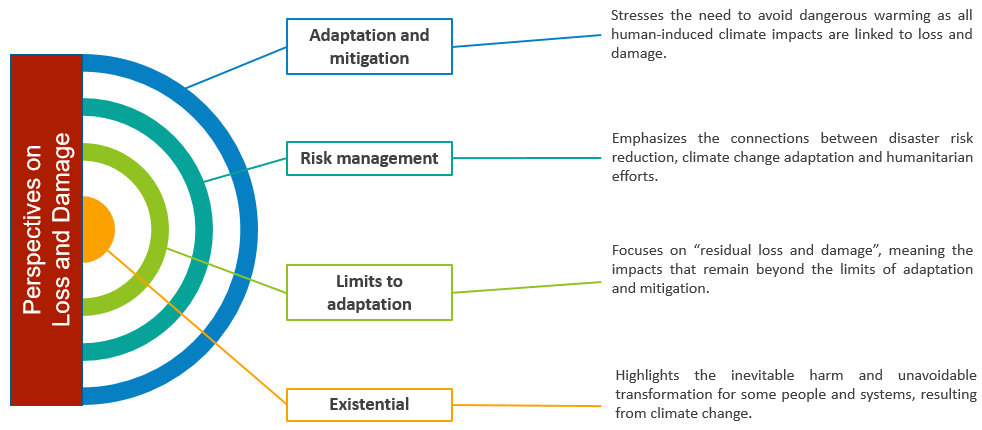
Types of Losses and Damages due to Climate Change
- Losses and damages due to climate change can be of two types i.e., economic losses and non-economic losses and damages which includes loss of societal beliefs and values, cultural heritage, and biodiversity.
- The report emphasized that the assessment of non-economic losses and damages is lacking and needs more attention.

Diplomatic ambiguity around the concept of Loss and Damage
- At the approval session for the report, several richer governments objected to any inclusion of the concept of loss and damage, due to concerns that it would raise the status of the issue in climate negotiations.
- Wealthy nations have long resisted efforts to set aside specific funding for loss and damage or accept liability for it based on their historical emissions.
- The Loss and Damage debate has been contentious within the international climate negotiations because of questions of fairness and equity, and proving historical responsibility for climate change, in paying for the losses and damages associated with climate change.
- Developing countries have called for compensation from developed countries, while developed countries have sought instead to treat losses and damage as a sub-component of adaptation.
- According to the Earth Negotiations Bulletin, Norway and the US rejected a proposal by a group of global south nations to refer to “economic losses and damages from climate change” instead of “economic damages from climate change”.
- During the negotiations, the US had pushed for “losses and damages” to be replaced with the word “impacts”. While this attempted change appears to have been unsuccessful, it resulted in a reference to “widespread losses and damages to nature and people” being replaced with “widespread adverse impacts and related losses and damages”.
Ways to reduce Losses and Damage
- It includes increasing resilience before the occurrence of an extreme weather or slow-onset event – for example:
- By strengthening flood defences – and establishing mechanisms to provide financial or social protection support to those who have already experienced losses and damage.
- Insurance is one important tool but is not affordable or accessible to all.
- A farther-reaching, more holistic approach can include longer-term finance to address slow-onset events, improved finance and planning for rapid post-event disaster relief, improved data collection and projections of future losses and damage, measures to reduce non-economic losses and damage, international agreement on the rights and status of persons displaced due to climate change, and mainstreaming climate change resilience across all investments and policy decisions.
- Article 8 of the Paris Agreement includes the “role of sustainable development in reducing the risk of loss and damage”. This can involve targeting the most vulnerable communities and developing policies that address the root causes of this vulnerability, to build resilience against future losses and damage.
- The following figure shows example actions on losses and damage at different geographical scales.
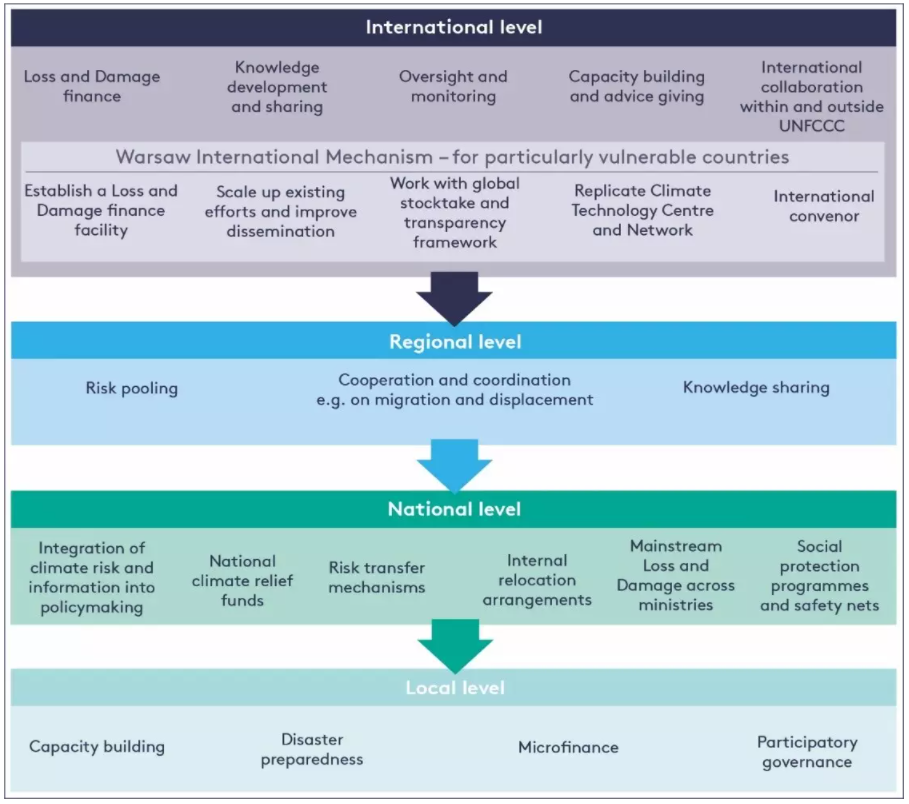
Feature #3 Climate Resilient Development
Background:
- The link between climate change and sustainable development has long been recognized and has been assessed in every WG2 report since AR3 in 2001.
- The concept of “climate-resilient development” was introduced in AR5 to help assess development trajectories that include coordinated adaptation and mitigation actions aimed at reducing climate risk.
- The AR6 report emphasizes the need for integrative and transformative solutions within a sector or region that address the uneven distribution of climate risks among different groups and geographies.
What is climate resilient development?
- The report defines climate-resilient development as “a process of implementing greenhouse gas mitigation and adaptation solutions to support sustainable development for all”. It explains that pursuing climate action and sustainable development in an integrated manner increases their effectiveness in enhancing human and ecological well-being.
- Climate-resilient development can help build capacity for mitigation and adaptation.

Pathways to climate resilient development
- The report defines climate-resilient pathways as development trajectories that combine adaptation and mitigation with effective institutions to realize the goal of sustainable development.
- There are “multiple possible pathways” to pursue climate-resilient development, which “involves confronting complex synergies and trade-offs”.
Current trends and prospects of climate resilient development around the world
- The report warns that current development trends along with the impacts of climate change are leading away from, rather than toward, sustainable development.
- These trends include rising income inequality, continued growth in greenhouse gas emissions, land use change, food and water insecurity, human displacement, and reversals of long-term increasing life expectancy trends in some nations.
- In turn, these trends contribute to worsening poverty, injustice and inequity, and environmental degradation, which can be further exacerbated through climate change by undermining human and ecological well-being.
- The report also says that climate resilient development is already challenging at current global warming levels.
- Response to global greenhouse gas emissions trajectories, regional and local development pathways, climate risk exposure, socioeconomic and ecological vulnerability, and the local capacity to implement effective adaptation and greenhouse gas mitigation options, differ depending on local contexts and conditions.
- For example, underlying social and economic vulnerabilities in Australasia exacerbate disadvantage among particular social groups and there is deep underinvestment in adaptation, given current and projected risks.
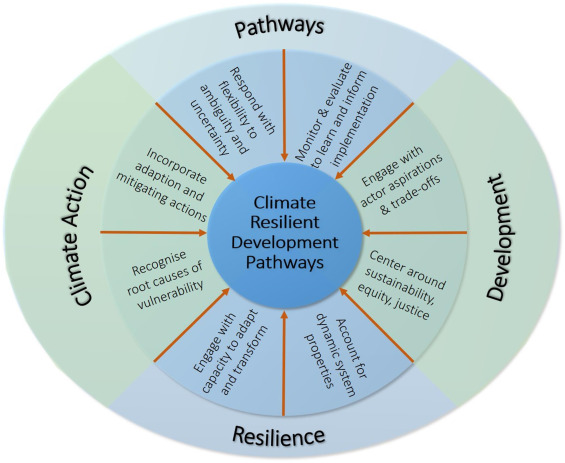
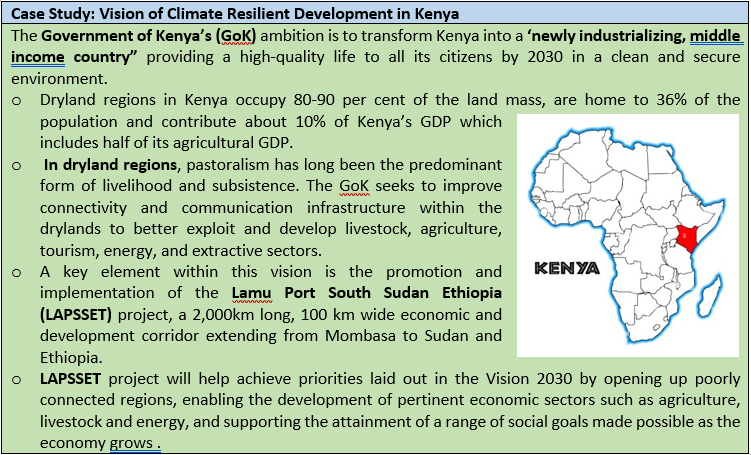
Climate Resilient Development for Natural and Human Systems
- Global trend of urbanization also offers a critical opportunity in the near-term, to advance climate resilient development:
- Integrated, inclusive planning and investment in everyday decision-making about urban infrastructure, including social, ecological and grey/physical infrastructures, can significantly increase the adaptive capacity of urban and rural settlements.
- Climate resilient development in urban areas also supports adaptive capacity in more rural places through maintaining peri-urban supply chains of goods and services and financial flows.
- Coastal cities and settlements play an especially important role in advancing climate resilient development.
- Urban climate resilient development is observed to be more effective if it is responsive to regional and local land use development and adaptation gaps, and addresses the underlying drivers of vulnerability.
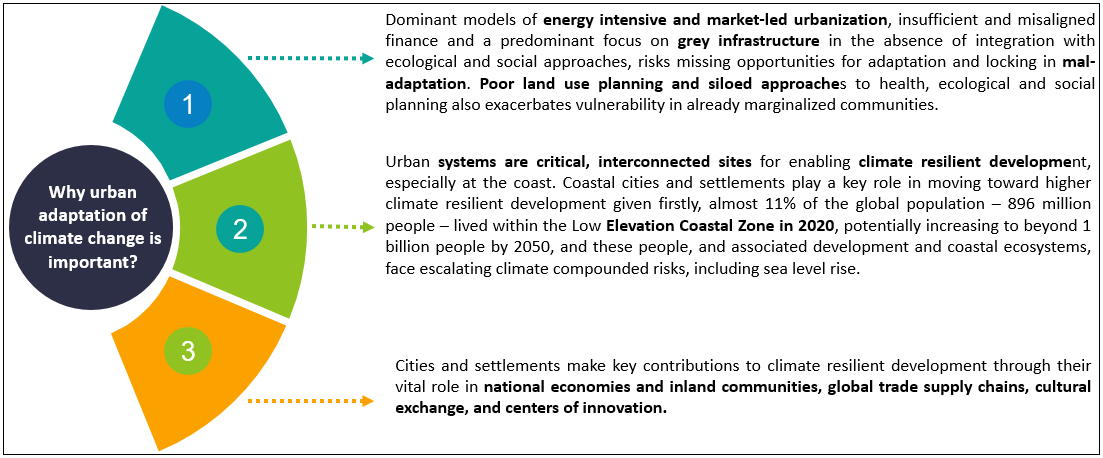
- Safeguarding biodiversity and ecosystems is fundamental to climate resilient development in light of the threats climate change poses to them and their roles in adaptation and mitigation:
- Building the resilience of biodiversity and supporting ecosystem integrity can maintain benefits for people, including livelihoods, human health and well-being and the provision of food, fiber and water, as well as contributing to disaster risk reduction and climate change adaptation and mitigation.
- Protecting and restoring ecosystems is essential for maintaining and enhancing the resilience of the biosphere.
- Degradation and loss of ecosystems is also a cause of greenhouse gas emissions and is at increasing risk of being exacerbated by climate change impacts, including droughts and wildfire.
- Climate resilient development avoids adaptation and mitigation measures that damage ecosystems. Documented examples of adverse impacts of land-based measures intended as mitigation, when poorly implemented, include afforestation of grasslands, savannas and peat lands, and risks from bio-energy crops at large scale to water supply, food security and biodiversity.
- Gender and climate change:
- An understanding of gendered relations is central to addressing the issue of climate change. This is because gender relations mediate experiences with climate change, whether in relation to water, forests, agriculture, marine systems, or urban environments.
- Climate change has direct negative impacts on women’s livelihoods due to their unequal control over and access to resources (e.g., land, credit) and because they are often the ones with the least formal protection.
- Women represent 43% of the agricultural labor force globally, but only 15% of agricultural landholders. Gendered and other social inequities also exist with non-land assets and financial services often due to social norms, local institutions, and inadequate social protection.
Conclusion: Understanding the positive and negative links of adaptation actions with gender equality goals, (i.e., SDG 5), is important to ensure that adaptive actions do not exacerbate existing gender-based and other social inequalities. Efforts are needed to change unequal power dynamics and ´to foster inclusive decision making for climate adaptation to have a positive impact for gender equality.
Share the article
Get Latest Updates on Offers, Event dates, and free Mentorship sessions.

Get in touch with our Expert Academic Counsellors 👋
FAQs
Geography Current Affairs focuses on the contemporary issues, events, and developments in the field of geography. It covers recent geographical phenomena, environmental changes, geopolitical shifts, and related news. This differs from regular geography studies which may focus more on foundational concepts, historical contexts, and theoretical frameworks.
Updates are provided regularly to ensure that subscribers stay informed about the latest developments in geography. Typically, updates are provided on a fortnightly basis, depending on the frequency of significant events and changes in the field.
Absolutely. Geography Current Affairs serves as a valuable resource not only for Geography optional but also for GS papers, especially GS Paper 1 (covering Indian Heritage and Culture, History, and Geography of the World and Society) and GS Paper 3 (covering Technology, Economic Development, Biodiversity, Environment, Security, and Disaster Management). It aids in building a holistic understanding of various topics and strengthens answer-writing skills by incorporating contemporary examples and perspectives.
Geography Current Affairs holds immense importance for UPSC preparation, particularly for aspirants opting for Geography optional. It helps candidates stay updated with the latest developments, geographical phenomena, environmental issues, and geopolitical shifts worldwide, aligning them with the dynamic nature of the subject as tested in the UPSC examinations.

